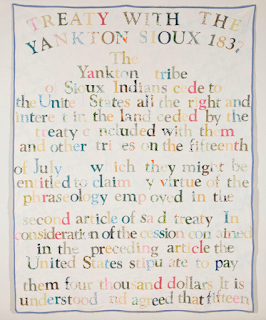Reflection (Gina Adams's Lawrence Installation)
Gina Adams was incredible to listen to; she was so friendly and patient, answering all the questions my Senior Seminar class had when we visited her before her talk. It's incredible how much she knows about each piece from memory: not only the intricacies of the treaties printed on them (which are difficult to read in so many ways), but also of the quilts (where she found them and the little history she could figure out about them) and the specific assistants who helped her make them. She would describe the various places where she found these old, lost, and forgotten quilts, disrupting their lost-and-forgotten-ness as they became canvases, to be viewed by many, for the treaties that have been given their own supposed lost-and-forgotten-ness by a society that continues to marginalize, silence, and oppress indigenous communities. This disruptive quality is what particularly struck me: a breaking of cycles.
McLuhan describes the importance of visual space: the "depend[ence] solely on the eye for comprehension" (44). While I don't fully agree with his point about comprehension of language through only the eye (I narrate in my head when I read, so I can't relate), I think that seeing holds a particular power in communication. Gina Adams was not reading the quilts to us (though sometimes she does in performances). She was taking the treaties, which society has attempted to bury and erase, and pulling them to the visible forefront. This is not the visual that McLuhan describes – "[v]isual space is uniform, continuous, and connected," – it is patches, mismatched, and disrupts the continuous silencing of the treaties and their relevance today.


